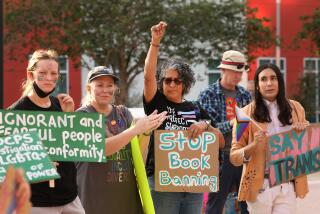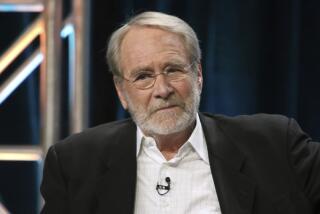Caught in a Furor of His Own Creation
MIDLOTHIAN, Scotland — The calm center of a storm over the science and morality of cloning is a reticent, red-whiskered Englishman named Ian Wilmut who, with the patience of one who has raised three children, is trying to reassure a world frightened by the shadows in his experiments.
In the days after the publication of his groundbreaking research, it seemed that Wilmut and his colleagues here at the Roslin Institute outside Edinburgh had cloned not a white-faced sheep named Dolly, but a series of intractable moral dilemmas. His creation disturbed a natural order of things, opening a way into a world in which, someday, a parent and child could be identical twins.
As the man who made the sheep that shook the world, Wilmut created difficulties for himself as well, disturbing the rural tranquillity that he seems to value above almost all else.
“I am a diffident Englishman,” he said. “I am trying my best to get [cloning] launched without getting my own life all tangled up in it.”
But tangled up it is. “He is going to have to live with being the human face of cloning,” said John Clark, one of Wilmut’s senior colleagues at the institute.
A private man who has become public property, Wilmut, 52, is a modest, single-malt-sipping, Cambridge-trained rambler of the Scottish border country. He makes his home with his wife, Vivienne, and a pet spaniel in a village of barely 500 that he declines to identify.
A scientist who cares passionately about the ethics of his work, he sees himself portrayed as a kind of soulless Strangelove who heedlessly unleashed this newest threat to humanity’s peace of mind.
It is an image of himself--and of science--that he and his colleagues barely recognize.
Wilmut has spent his life trying to pick the locks of the living cell, in the hope he could solve one of its most enduring mysteries. His successful cloning experiment--made public Feb. 22--should have been the pinnacle of his career, meant to pave the way for a new field of genetic engineering.
Instead, the most concrete result of his landmark experiment may be a U.S. ban on human cloning research, to avoid something that Wilmut is emphatic should never be attempted.
“We feared the response,” said Peter Sharp, who runs the institute’s division of development and reproduction in which Wilmut works. “We are absolutely appalled. When things like Dolly crop up, it tests the faith in science to the limit. “
Now the British House of Commons has requested that Wilmut testify in London today; Congress wants him to answer its questions in Washington on Wednesday. The Vatican would like the moral meaning of cloning clarified; so would a presidential bioethics commission.
But the one man whom everyone expects to have the answers is himself bemused.
“One misconception is that scientists are any more farsighted than anyone else,” Wilmut sighed. “We are not. Most of the things this technique will be used for have not yet been imagined.”
Is science outracing ethics?
“I know I am struggling to keep up,” Wilmut said.
Taking Heat, Sharing Credit
Wilmut has lived in Scotland for 23 years--long enough for his English accent to acquire the native burr. The institute where he works, seven miles southwest of Edinburgh, is a secluded cluster of poultry sheds, cattle barns, silos and one-story barracks of laboratories, all set off from the neighboring village of Roslin by green belts of trees, security gates and surveillance cameras.
Within this compound, about 300 molecular biologists, genetic engineers and research scientists are redesigning the livestock on which humankind depends. They are conceiving 21st century cattle, pigs, chickens and sheep genetically tailored to produce drugs in their milk or eggs, to grow faster, fatter and be more disease-resistant.
Like Wilmut, the institute values its privacy.
Six years ago, animal rights activists set fire to the laboratories, causing several million dollars worth of damage. Today, institute officials warn visitors to avoid taking pictures that might show the license plates on staff cars.
Wilmut works on a government salary of about $60,000 a year in an office not much larger than a Land Rover. He drinks his tea from a Wallace and Gromit cartoon mug, types his research reports on a battered Macintosh II computer, and carries files home in a worn, white canvas bag.
He is an energetic wisp of a man, whose engaging gap-toothed grin was rarely in evidence this week.
As he prowled the institute’s corridors, his colleagues had to trot to keep pace. When he sat, he coiled himself like a spring, his legs crossed and his arms folded across his chest to contain the tension. Unruly threads of reddish blond hair rose from his head like steam.
The controversy over cloning was only one of his problems.
As part of a recent economy drive, the British government cut his cloning funding over the weekend. Agricultural officials maintain that the cutback had nothing to do with the furor over the cloning experiment.
Still, fumed Wilmut, “it is no way to treat people.” While he certainly is the most visible person involved in the experiment, Wilmut sees himself as a scientist who succeeds by orchestrating the efforts of other researchers. He probably spends more time writing grant proposals and counseling other scientists than he does working on his personal projects.
Indeed, he attributes the key insight that made the experiment work to a colleague, Keith H.S. Campbell, who realized it was necessary to make sure that the donor cell and the egg were both in the same stage of development.
“The way you achieve things is to bring out opportunities for other people,” Wilmut said. “So I don’t do much experimental work. I am in lab meetings. I do some of the [animal] surgery sometimes.” Others might want to be more directly involved in the experiments, but “that’s the way I am,” he said.
He also admitted that his hands are too clumsy for the delicate motions required in microsurgery on embryos and donor cells.
But those minor imperfections have been overshadowed by his leadership. His colleagues say he has pursued the work with remarkable tenacity for more than a decade.
“He has hit the treasure trove now, but he had a long hard time,” said Alan Colman, research director at PPL Therapeutics in Roslin, a biotechnology company that collaborated in the experiment.
“Ian was in the wilderness. He was having a tough time justifying his existence.”
Laying the Groundwork
Wilmut finished his doctoral degree at Cambridge University in 1973, helping to pioneer techniques to freeze sperm.
He studied in an influential but little-known animal research unit that trained a cadre of reproductive physiologists who revolutionized the science of sex. Their inventions ranged from the development of test-tube babies and the use of fertility drugs to frozen embryos and embryo surgery.
Working there, Wilmut was the first to produce a calf from a frozen embryo. There is a picture of the calf--Frosty--on his desk.
And when he left the lab, his place was taken by a young Danish scientist named Steen Willadsen who in 1986 became the first to produce multiple genetic copies of sheep by splitting cells from a developing embryo, which foreshadowed Wilmut’s experiments.
“That really set the stage” for cloning, Willadsen said.
It took a decade more until Wilmut achieved what most scientists consider true cloning--growing an animal from adult cells.
By somehow prodding the genes inside an adult sheep cell into wakefulness, Wilmut and his team were able to make that cell revert to its biological infancy. From it they grew a genetic copy of the original animal from which the cell was taken.
In her guarded pen earlier this week, Wilmut’s brainchild peacefully chewed handfuls of Super Ewe sheep feed, pranced around and greeted the media with a full-throated bleat.
“There is this fear made flesh,” said Harry Griffin, the institute’s deputy science director.
In the adjacent stall, two sheep nuzzled. Meagan and Morag are clones of a slightly different variety, created by Wilmut’s team last year from embryonic cells. (That technique also was used by Oregon researchers, who announced last week that they had cloned two monkeys.) One of them is pregnant, proving that such cloned creatures can reproduce normally.
For the foreseeable future, however, Dolly will remain one of a kind. Wilmut said he has no immediate plans to use adult cells to clone her or any other animal.
Since her birth, however, Wilmut and his colleagues have wasted no time creating a new generation of genetically altered cloned sheep, but they are working only with clones cultivated from fetal cells. These types of experiments have greater promise for those interested in quickly producing large numbers of animals genetically engineered to produce useful pharmaceutical compounds or possess more productive traits, he said.
“Maybe we will do some more experiments with the adult cells, but we are not doing them now,” he said, “because we are working toward precise genetic modifications with fetal cells.”
With practiced understatement, Wilmut downplayed the importance of his work and its potential impact on humankind.
“I am not actually sure it is an incredible breakthrough. This is a useful scientific technique. It is not remotely equivalent to setting off the atomic bomb.
“There is an analogy that I think is more appropriate and that is organ transplantation,” he said. “We forget what a stir that caused around the world, in part because of the emotional attachment people place on the heart.”
Nonetheless, Dolly does turn some of the simplest human preconceptions on their head. Even something as rudimentary as her age is imponderable. Is she actually 8 months old--her apparent gestational age--or is she more than 6 years old--the age of the animal from whose udder cell she was cultivated?
“That’s a fascinating question,” Wilmut said politely. “But we don’t have the answer yet.”
Only a detailed analysis of genes will reveal her true biochemical age.
Irked by Nightmare Scenarios
While he shares the public concern over the technology he has created, Wilmut is irritated by some of the more exotic nightmare scenarios being outlined and is angered by the assumption that someone who has spent his life working in his field might be blind to its unsettling implications.
Wilmut says he has no religious beliefs. His wife is an elder of the Church of Scotland. He has worked closely with church leaders assessing the moral implications of such research. When it came time to patent the cloning technique earlier this year, he insisted that the patent language explicitly exclude any application to humans.
His hands fidgeted as he talked, clasping and unclasping. It was the only sign that a man under rigid emotional control was starting to fray with fatigue.
“We are concerned that the technique not be misused, so we are very keen to see legislation,” he said. “We think it is important to effectively prohibit cloning in humans.”
His temper flared. “We always talk [about the misuse of cloning] as if this will happen in some other country, never ours. I am quite surprised that we are so arrogant about our own level of morality and so disparaging about others.
“Little cloned copies of despots are not frightening. It is the big despot alive now that is frightening,” he said. “Saddam Hussein is more frightening than any clone he could make.”
The cloning experiment has highlighted the tensions between science and the society it seeks to serve, he acknowledged.
In his view, science is meant to exploit the new opportunities it creates, and its findings should be published as openly as possible. Secrecy is an anathema, as is any effort to stifle basic research, he said.
“If academic research does produce things that are useful, like therapeutic proteins or methods of embryo freezing, they should be taken and used,” he said.
“The objectives we always had with this project were to produce methods for making precise genetic change in livestock and for making copies of embryos. It is legitimate to do things in farm animals that you would not do in humans.
“There is some suggestion that this work was not properly assessed before it was started. . . . How do you regulate things beforehand?” he said. “That is the antithesis of science. The only appropriate thing is to regulate something carefully after it has been published and described.”
By the time Dolly was born, her progenitor--the language has yet to coin a more precise word for the creature that contributed her cell--was long dead. Her udder cells had been frozen and stored until they were used to produce the cloned sheep.
The researchers inserted the cells into 277 eggs to make clone embryos. Many survived the transfer into the wombs of other sheep, but only one survived to birth.
At tea time on July 5, Dolly came head-first into the world.
“I can’t remember anything about the day the lamb was born,” Wilmut said.
But no matter how many times he answers, the questions remain.
And there is no shortage of people waiting to ask them.
The phone is ringing again. The institute has answered 2,000 calls about cloning in less than two weeks. The fax spits out another letter of inquiry. The security gate is buzzing as a reporter seeks admission after closing hours.
On this night, Wilmut heads for the pub, where the man who has developed biotechnology’s newest innovation indulges himself in one of its oldest--a pint of brown ale.
“Ian’s about to enter meltdown,” said Harry Griffin.






